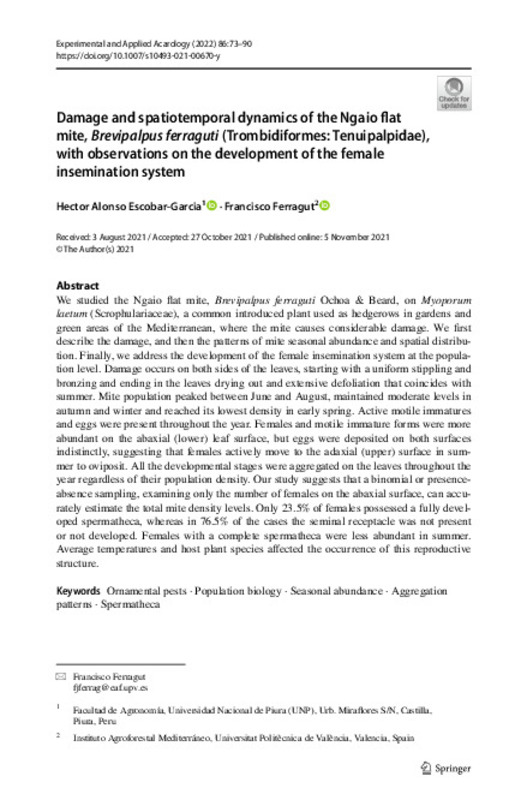AEMET (2020) Agencia Estatal de Meteorología. Available online: http://www.aemet.es/es/eltiempo/observacion/ultimosdatos?k=val&l=8416Y
Alberti G, Tassi AD, Kitajima EW (2014) Part 6: Female reproductive system. In: Alberti G, Kitajima EW (eds) Anatomy and fine structure of Brevipalpus mites (Tenuipalpidae)–economically important plant-virus vectors. Schweizerbart Science Publishers, Stuttgart
Alves JLS, Ferragut F, Mendonça RS, Tassi AD, Navia D (2019) A new species of Brevipalpus (Acari: Tenuipalpidae) from the Azores Islands, with remarks on the B. cuneatus species group. Syst Appl Acarol 24(11):2184–2208. https://doi.org/10.11158/saa.24.11.10
[+]
AEMET (2020) Agencia Estatal de Meteorología. Available online: http://www.aemet.es/es/eltiempo/observacion/ultimosdatos?k=val&l=8416Y
Alberti G, Tassi AD, Kitajima EW (2014) Part 6: Female reproductive system. In: Alberti G, Kitajima EW (eds) Anatomy and fine structure of Brevipalpus mites (Tenuipalpidae)–economically important plant-virus vectors. Schweizerbart Science Publishers, Stuttgart
Alves JLS, Ferragut F, Mendonça RS, Tassi AD, Navia D (2019) A new species of Brevipalpus (Acari: Tenuipalpidae) from the Azores Islands, with remarks on the B. cuneatus species group. Syst Appl Acarol 24(11):2184–2208. https://doi.org/10.11158/saa.24.11.10
Awmack CS, Leather SR (2002) Host plant quality and fecundity in herbivorous insects. Ann Rev Entomol 47:817–844. https://doi.org/10.1146/annurev.ento.47.091201.145300
Beard JJ, Ochoa R, Bauchan GR, Trice MD, Redford AJ, Walters TW, Mitter C (2012) Flat Mites of the World Edition 2. Identification Technology Program, CPHST, PPQ, APHIS, USDA; Fort Collins, CO. Accessed May 26th 2021. http://idtools.org/id/mites/flatmites/
Beard JJ, Ochoa R, Braswell WE, Bauchan GR (2015) Brevipalpus phoenicis (Geijskes) species complex (Acari: Tenuipalpidae) a closer look. Zootaxa 3944:1–67. https://doi.org/10.11646/zootaxa.3944.1.1
Childers CC, French JV, Rodrigues JCV (2003) Brevipalpus californicus, B. obovatus, B. phoenicis, and B. lewisi (Acari: Tenuipalpidae): a review of their biology, feeding injury and economic importance. Exp Appl Acarol 30:5–28. https://doi.org/10.1023/B:APPA.0000006543.34042.b4
Di Palma A, Tassi AD, Kitajima EW (2020) On some morphological and ultrastructural features of the insemination system in five species of the genus Brevipalpus (Acari: Tenuipalpidae). Exp Appl Acarol 81(4):531–546. https://doi.org/10.1007/s10493-020-00526-x
EPC (European Parliament and Council) (2009) Directive 2009/128/EC of the European Parliament and of the Council of 21 October 2009 establishing a framework for Community action to achieve the sustainable use of pesticides. Official J L 309:71–86
Fuller TC, McClintock EM (1986) Poisonous plants of California. University of California Press, Berkeley, p 384
Groot TWM, Janssen A, Pallini A, Breeuwer JAJ (2005) Adaptation in the asexual false spider mite Brevipalpus phoenicis: evidence for frozen niche variation. Exp Appl Acarol 36:165–176. https://doi.org/10.1007/s10493-005-3360-6
Haramoto FH (1966) Biology and control of Brevipalpus phoenicis (Geijikes) (Acarina: Tenuipalpidae). PhD Dissertation, University of Hawaii 113 pp
Helle W, Bolland HR, Heitmans WRB (1980) Chromosomes and types of parthenogenesis in the false spider mites (Acari: Tenuipalpidae). Genetica 54:45–50. https://doi.org/10.1007/BF00122407
Jeppson LR, Keifer HH, Baker EW (1975) Mites injurious to economic plants. University of California Press, Berkeley, p 614
Krantz GW, Walter DE (2009) Collecting, rearing, and preparing specimens. In: Krantz GW, Walter DE (eds) A manual of acarology, 3rd edn. Texas Tech University Press, Lubbock, pp 83–94
Lea-Cox JD, Syvertsen JP (1996) How nitrogen supply affects growth and nitrogen uptake, use-efficiency, and loss from Citrus seedlings. J Am Soc Hort Sci 121:105–114. https://doi.org/10.21273/JASHS.121.1.105
Legaz F, Primo-Millo E, Primo-Yufera E, Gil C, Rubio JL (1982) Nitrogen fertilization in citrus. I. Absorption and distribution of nitrogen in calamondin trees (Citrus mitis Bl.), during flowering, fruit set and initial fruit development periods. Plant Soil 66:339–351. https://doi.org/10.1007/BF02183800
Mineiro JLC, Sato ME, Raga A, Arthur V (2008) Population dynamics of phytophagous and predaceous mites on coffee in Brazil, with emphasis on Brevipalpus phoenicis (Acari: Tenuipalpidae). Exp Appl Acarol 44:277–291. https://doi.org/10.1007/s10493-008-9149-7
Mohamed SM, Omer EA (2009). Seasonal variations in the volatile oil of Myoporum laetum leaves. Med Aromat Plant Sci Biotechnol (Special issue 1): 50–51.
Navia D, Mendonça RS, Ferragut F, Miranda LC, Trincado RC, Michaux J, Navajas M (2013) Cryptic diversity in Brevipalpus mites (Tenuipalpidae). Zool Scr 42:406–426. https://doi.org/10.1111/zsc.12013
Ochoa R, Aguilar H, Vargas C (1994) Phytophagous mites of Central America: An illustrated guide. CATIE, Serie Técnica, Manual Técnico No. 6, English edition, 234 pp
Oomen PA (1982) Studies on population dynamics of the scarlet mite, Brevipalpus phoenicis, a pest of tea in Indonesia. Mededelingen Landbouwhogeschool, Wageningen, p 98
Petanović R, Kielkiewicz M (2010) Plant–eriophyoid mite interactions: cellular biochemistry and metabolic responses induced in mite-injured plants. Part i Exp Appl Acarol 51:61–80. https://doi.org/10.1007/s10493-010-9351-2
Raupp MJ, Shrewsbury PM, Herms D (2010) Ecology of herbivorous arthropods in urban landscapes. Annu Rev Entomol 55:19–38. https://doi.org/10.1146/annurev-ento-112408-085351
Razoux-Schultz L (1961) Enkele notities over de oranje mijt, Brevipalpus phoenicis (Geijskes), op thee in Indonesië. Mededelingen Landbouwhogeschool Gent 26:1694–1702
Shi A, Tomczyk A (2001) Impact of feeding of eriophyid mite Epitrimerus gibbosus (Nalepa) (Acari: Eriophyoidea) on some biochemical components of blackberry (Rubus spp.). Bull Polish Acad Sci Biol Sci 49(1):41–47
SPSS (2011) SPSS Statistics Version 19, USA [Software]. https://www.ibm.com/support/pages/spss-statistics-190-fix-pack-1 (accessed Apr 30 2020)
StatGraphics (2009) StatGraphics Centurion XVIII Version 18, USA [Software]. http://www.statgraphics.net/descargas/ (accessed Apr 30 2020)
Sudo M, Osakabe M (2011) Do plant mites commonly prefer the underside of leaves? Exp Appl Acarol 55:25–38. https://doi.org/10.1007/s10493-011-9454-4
Tassi AD (2018) Diversidade morfologica e genetica de diferentes especies de Brevipalpus (Acari: Tenuipalpidae) e suas competencias como vetores de virus. PhD Dissertation. Universidade de Sao Paulo/Escola Superior de Agricultura “Luiz de Queiroz”. Piracicaba, 262 pp
Tassi AD, Alves JLS, Navia D, Mendonça RS, Kitajima EW (2018) First report of Brevipalpus ferraguti Ochoa & Beard (Tenuipalpidae) in Brazil, and its possible role as vector for some Brevipalpus-transmitted virus. Anais do III Congresso Latinoamericano de Acarologia e VI Simpósio Brasileiro de Acarologia, Pirenópolis, Goiás, Brasil. Available from: http://www.infobibos.com/anais/sibac/6/resumos/ResumoClac3Sibac6_0159.pdf
Taylor L (1961) Aggregation, variance and the mean. Nature 189:732–735. https://doi.org/10.1038/189732a0
Taylor L (1984) Assessing and interpreting the spatial distributions of insect populations. Annu Rev Entomol 29:321–357. https://doi.org/10.1146/annurev.en.29.010184.001541
Weeks AR, Marec F, Breeuwer JAJ (2001) A mite species that consists entirely of haploid females. Science 292:2479–2482. https://doi.org/10.1126/science.1060411
Wilson L, Room PM (1983) Clumping patterns of fruit and arthropods in cotton, with implications for binomial sampling. Environ Entomol 12:50–54. https://doi.org/10.1093/ee/12.1.50
[-]









